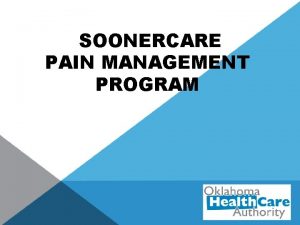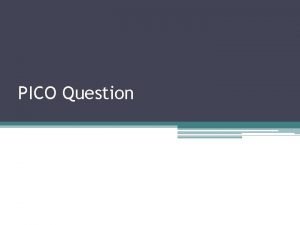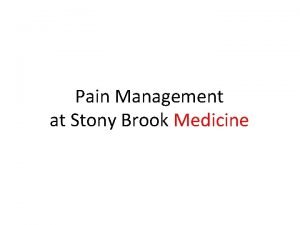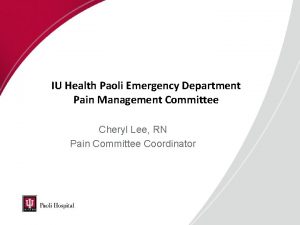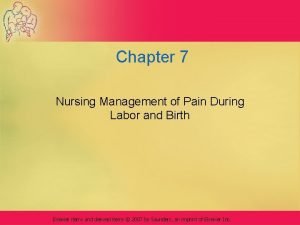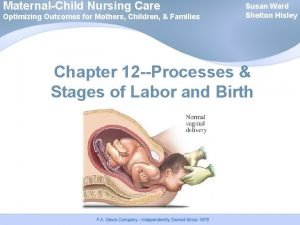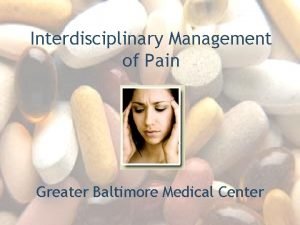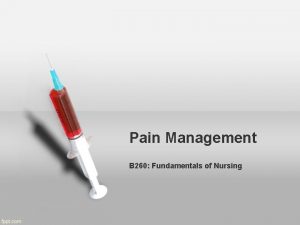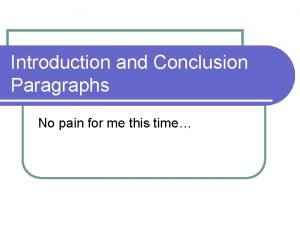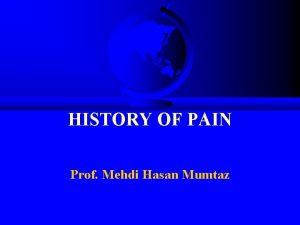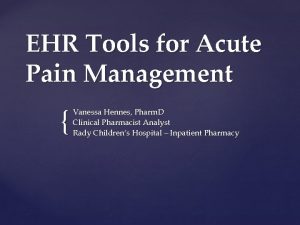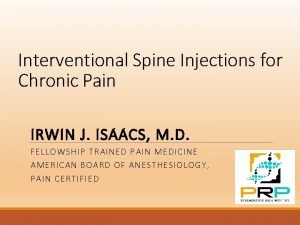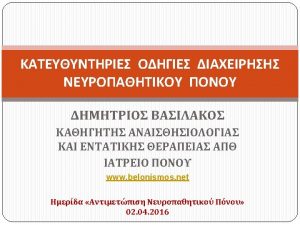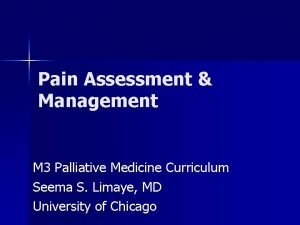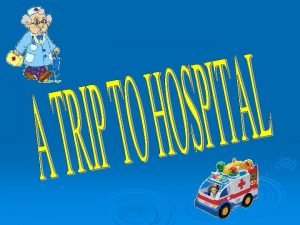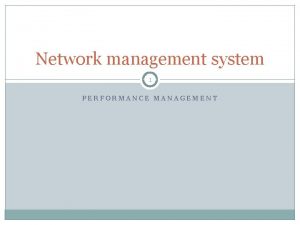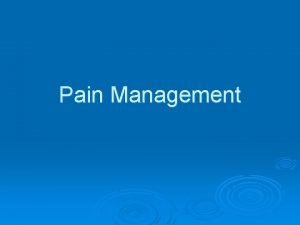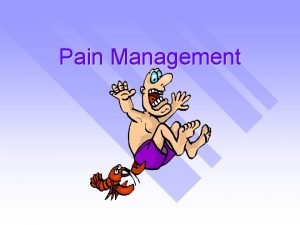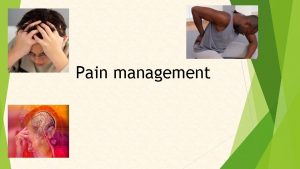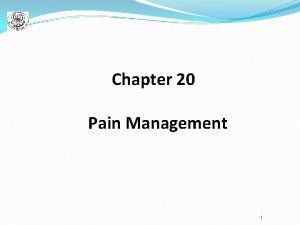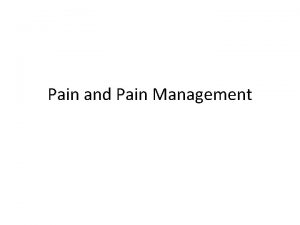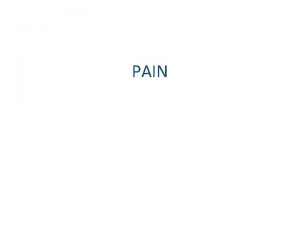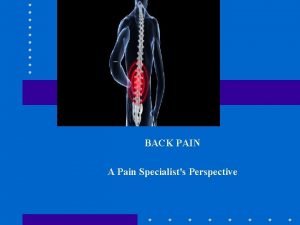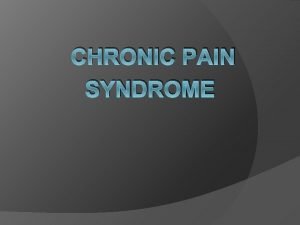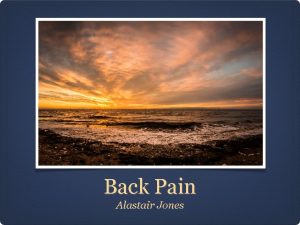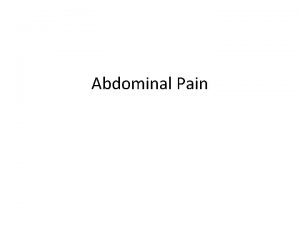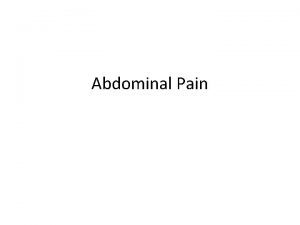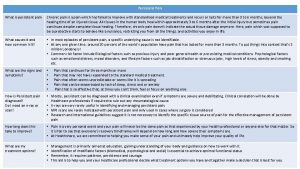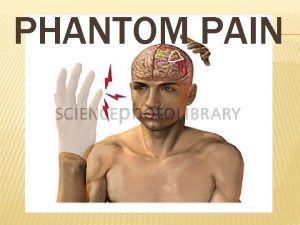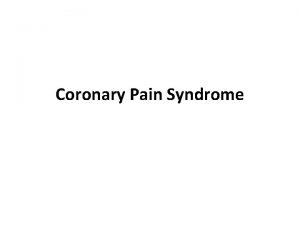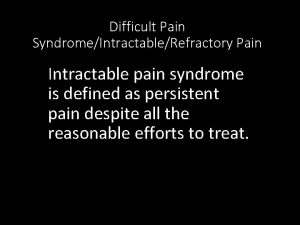Pain management What is pain Pain is a













































- Slides: 45

Pain management

What is pain? • Pain is a difficult word to define • Patients use different words to describe pain • eg. Aching, Pins and needles, Annoying, Pricking, Biting, Hurting, Radiating, Blunt, Intermittent, Burning, Sore, Miserable, Splitting, Cutting, Nagging, Stabbing, Crawling, Stinging, Crushing, Tender, Dragging, Numbness, Throbbing, Dull, Overwhelming, Tingling, Electric-shock like, Penetrating, Tiring, Excruciating, Piercing, Unbearable • The fifth vital sign” – American Pain Society 2003� Identifying pain as the fifth vital sign suggests that the assessment of pain should be as automatic as taking a client’s BP and pulse

what is pain ? • Pain is : an unpleasant sensory and emotional experience associated with actual or potential tissue damage, or described in terms of such damage • It is a symptom. • Associated signs are crying, sweating, increased heart rate, blood pressure, behavioral changes.

What is the pain score for this player?

PAIN types : Acute I j pain- lasts only through the expected recovery period whether it has a sudden or slow onset and regardless of intensity. Chronic pain- is prolonged, usually recurring and persisting over 6 months or longer, and interferes with functioning.

� ACUTE: onset is well defined, response to tissue injury, responds to pain treatment, associated with anxiety, affects the individual � CHRONIC PAIN: Onset is ill defined, response to change in nervous system, less response to medication, associated with depression, involves social network

Another classification of pain according to source NOCICEPTIVE NEUROPATHIC Visceral Somatic • bones, joints • connective tissues • muscles • Organs – heart, liver, pancreas, gut, etc. Deafferentation Sympathetic Maintained Peripheral

Pathophysiology of pain

Pain - Receptors • Nociceptors are special receptors that respond only to noxious stimuli and generate nerve impulses which the brain interprets as “pain • There are two types of fibers that transmit pain : C-fibers and A-delta fibers. • Activated by stimuli (mechanical, thermal, chemical) • Distinguished from other receptors by – their higher threshold, and – they are normally activated only by stimuli of noxious intensity-sufficient to cause some degree of tissue damage.

NOCICEPTION The peripheral nervous system includes primary sensory neurons specialized to detect mechanical, thermal or chemical conditions associated with potential tissue damage. The signals, when these nociceptors are activated, must be transduced and transmitted to the spine and brain where signals are modified before they are ultimately understood or “felt”. 4 physiologic processed involved ( transduction, transmission, perception, and modulation)

1 - TRANSDUCTION During this stage, noxious stimuli ( with potential to injure tissue) trigger the release of biochemical mediators (prostaglandins, bradykinin, serotonin, histamine, substance P) that sensitize nociceptors. Noxious or painful stimulation also causes movement of ions across cell membranes, which excites nociceptors.

Pain medication can work during this phase by blocking the production of prostaglandin(e. g. , ibuprofen or aspirin) or by decreasing the movements of ions across the cell membrane (e. g. , local anesthetic).

2 - TRANSMISSION Includes 3 segments. First segment- pain impulse travels from the peripheral nerve fibers to the spinal cord Substance P serves as neurotransmitter. Two types of nociceptors cause this transmission to dorsal horn of the spinal cord: C fibres transmit dull pain and Adelta fibres which transmit sharp, localized pain. . Second segment- transmission from the spinal cord and ascension via spinothalamic tracts, to the brain stem and thalamus. Third segment- involves transmission of signals between thalamus and somatic sensory cortex where pain perception occurs.


Pain control can take place during this second process. Opoids (narcotic analgesics) block the release of neurotransmitters, particularly substance P, which stops the pain at the spinal level. Capsaicin may also deplete substance P that could inhibit the transmission of pain signals.

3 - MODULATION Often descibed as “descending System” Occurs when neurons in the thalamus and brain stem send signals down to the dorsal horn of the spinal cord. These descending fibers release substances such as endogenous opoids, serotonin, and norepinephrine which can inhibit the ascending noxious(painful) impulses in the dorsal horn.

4 - PERCEPTION Is when the client becomes conscious of the pain. Pain perception is the sum of complex activities in the Central Nervous System that may shape the character and intensity of pain perceived and ascribe meaning to the pain.

Theories of pain Intensity theory touch pain There is a single pathway for touch and pain Less intensity produces touch Increased intensity produces pain Specificity theory touch pain There are two different pathways for touch and pain

Gate control theory • This explains how pain can be relieved very quickly by a neural mechanism • First described by P. D. Wall & Melzack (1965) • “There is an interaction between pain fibres and touch fibre input at the spinal cord level in the form of a ‘gating mechanism’

Gate control theory pain is felt pain + gate is opened When pain fibre is stimulated, gate will be opened & pain is felt

Gate control theory pain is not felt touch + pain gate is closed When pain and touch fibres are stimulated together, gate will be closed & pain is not felt

Gate control theory • This theory provided basis for various methods of pain relief – Massaging a painful area – Applying irritable substances to a painful area (counter-irritation) – Transcutaneous Electrical Nerve Stimulation (TENS) – Acupuncture ?

. Pharmacological Treatment of Pain A Non. Opioids B Opioids C Adjuvants


A-Non-Opioids Paracetamol (Panadol): PO, IV. Act centrally & peripherally Cox-1, N Cox-2 inhibitor s Non-steroidal Anti-inflammatory Drugs (NSAIDs) Ketorolac (Toradol)- inj Ibuprofen (Advil, Neurofen, Brufen) Diclofenac Na/K (Voltaren, Olfen, Cataflam) Cox-2 inhibitor s Mefanemic acid (Ponstan) Naproxen (naproysen Celebrex (Celecoxib) Etoricoxib (Arocoxia)

A- NSAIDs mechanism of action

NSAIDs Ketorolac (Toradol): � Postoperatively for max 5 days � Reduce amount of opioid requirement, reduce S. E’s � Dose= 15 – 30 mg IV / IM Q 6 hrs Cox-2 inhibitors: Effective anti-inflammatory in arthritis � Carry cardiovascular risk warning � Less GI S. E’s �

NSAID Side effects: Prolong bleeding time Gastric erosions/ ulceration/ perfusion Affect kidney function: _ Water / electrolyte balance _ Interfere with diuretics/ antihypertensive _ Renal injury / nephrotic syndrome

B- Opioids

Opioid Receptors • Opioid receptors found in the brain, spinal cord and peripheral nervous system • Mu (μ 1 and μ 2 ) • Kappa (k 1 & k 3) • Delta (δ) • Nociceptin/Orphanin (N/OFQ) So the opioid will bind to these receptors leading to differernt reactions that produce its analgesic effect

Spinal sites of opioid action. hyperpolarize second-order pain transmission neurons by increasing K+ conductance, evoking an inhibitory postsynaptic potential reduce transmitter release from presynaptic terminals of nociceptive primary afferents

Opioid drugs that I will discuss 1 -Morphine 2 -Codiene (Methyl Morphine) 3 -Pethidine 4 -Fentanyl 5 -Tramadol

1 -Morphine

Efficacy • • Morphine is a strong analgesic. Higher doses can decrease even severe pain Degree of analgesia increasing with dose. Simultaneous action at spinal and supraspinal sites greatly amplifies the analgesic action.

Mood and subjective effects • Morphine has a calming effect. • The associated reactions to intense pain – apprehension, – fear, • Perception of pain and reaction to it are both altered so that pain is no longer as unpleasant or distressing, i. e. patient tolerates pain better.

Mood and subjective effects In patients - Pain relief No addiction In normal persons Dependence and Addiction

Therapeutic uses • Morphine / parenteral congeners indicated as analgesic in traumatic, visceral, ischaemic (myocardial infarction), Postoperative , burns, cancer pain. • Relieves anxiety and apprehension in serious and frightening disease accompanied by pain: myocardialinfarction. • Dose : Bolus: 2 -5 mg slowly over 5 min (Q 1 -3 hrs). IM; 5 -10 mg (Q 3 -4 hrs). SC: not recommended in repeated dose

2 -Codiene (Methyl Morphine) • • • low-efficacy opioid lacks efficacy for severe pain most of its actions 1/10 th those of morphine. Large doses cause excitement. Dependence much less than with morphine. principal use: mild to moderate pain & cough

3 -Pethidine differs from morphine in that it: does not usefully suppress cough less likely to constipate less likely to cause urinary retention & prolong childbirth • little hypnotic effect • shorter duration of analgesia (2 -3 h). • Dose: 50 -100 mg SC or IM • •

4 -Fentanyl • Fentanyl is 80 -100 times potent than morphine in analgesia and resp. depression • High lipid solubility , peak effect in 5 min • Duration of action 30 -40 min • Injectable form exclusively used in anaesthesia • Transdermal patch available used in cancer or other types of chronic pain • Dose: 25 -75 µg /hr acts for 72 hours

5 -Tramadol • Relieves pain by opioid as well as other mechanisms • 100 mg IV Tramadol = 100 mg IM morphine • Dose: 50 -100 mg TDS(3 times a day ) • Less respiratory depression, sedation, constipation, urinary retention, ↑intrabiliary pressure & dependence than morphine • As effective as pethidine for postoperative pain and as morphine for moderate chronic pain.

Opioids Side Effects Nausea and vomiting Constipation Pruritis Irritable movement Psychomimetic effects Sedation Broncho-constriction Respiratory Depression N. B: If respiratory depression/sedation develops, the nurse must be familiar with administration of Naloxone, which will reverse the effect. Naloxone is diluted (0. 4 mg in 10 m. L NS) every 1 -2 min until the patient's respiratory status improves and the patient starts to arouse.

C-Adjuvants Agents used to induce analgesic effect indirectly Local anesthetics Antidepressants Anticonvulsants Corticosteroids Muscle relaxants Anti histamines

4. Choice of Drugs in Treatment of Acute /chronic

4. Choice of Drugs in Treatment of Acute / Chronic Pain
 Mad pain and martian pain
Mad pain and martian pain Pms or pregnancy
Pms or pregnancy Pms vs pregnancy symptoms
Pms vs pregnancy symptoms Top management middle management first line management
Top management middle management first line management Management pyramid
Management pyramid Top management and middle management
Top management and middle management Pain management okc soonercare
Pain management okc soonercare What is pico method
What is pico method Pain management stony brook
Pain management stony brook Iu health pain management
Iu health pain management Chapter 7 nursing management of pain during labor and birth
Chapter 7 nursing management of pain during labor and birth Ruben gonzalez vallina
Ruben gonzalez vallina Fetal descent stations
Fetal descent stations Gbmc pain management
Gbmc pain management Pain management specialist
Pain management specialist Fundamentals of nursing pain management
Fundamentals of nursing pain management Dr danko pain management
Dr danko pain management Upside down triangle introduction paragraph
Upside down triangle introduction paragraph Dr. mehdi pain management
Dr. mehdi pain management Pain management ehr
Pain management ehr Lumbar referral patterns
Lumbar referral patterns Res pain management
Res pain management Dr lascarides pain management
Dr lascarides pain management Pain management synonym
Pain management synonym Time management in human resource management
Time management in human resource management Performance management network definition
Performance management network definition Asset management vs project management
Asset management vs project management Configuration management in project management
Configuration management in project management Crm in logistics and supply chain management
Crm in logistics and supply chain management Retail organization
Retail organization Principles of project cost management
Principles of project cost management Scientific management vs administrative management
Scientific management vs administrative management Accounting management in network management
Accounting management in network management Human resources defintion
Human resources defintion Tahapan sales cycle
Tahapan sales cycle Quality management in operations management
Quality management in operations management Traditional management vs entrepreneurial management
Traditional management vs entrepreneurial management Enterprise resource planning ppt
Enterprise resource planning ppt Chain sequence
Chain sequence What is software configuration management
What is software configuration management Chapter 12 inventory management
Chapter 12 inventory management Hod math
Hod math Importance of software project management
Importance of software project management Demand management and capacity management
Demand management and capacity management Focusing on broad organizational needs
Focusing on broad organizational needs Managing entity network management
Managing entity network management






